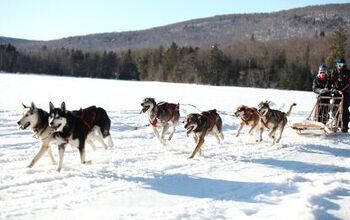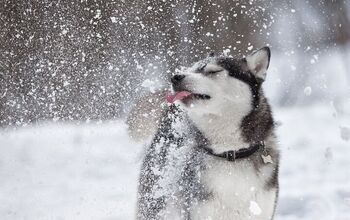Dogs Get A Kick Out Of Kicksledding

Kev Roberts, our resident expert on all sports that include dog pulling, wants to introduce you to yet another cold weather activity you can do with your dogs – kicksledding. From the looks of it, kicksledding looks like a lot of fun, for both owners and dogs. Read on to learn more about this cool sport (pun intended).
A kicksled is a long metal and wooden sled that you propel by kicking. While there are many variations of kicksleds, they all look similar: like a chair on a long pair of metal skis. To propel a kicksled, you stand on the runners, hang on to the handle bar, and kick to move it forward.
Most kicksleds are lightweight and fold down, nearly flat, or flat enough to fit in a car. Their light weight, and ease of transport make them ideal for people to use them with dogs. It’s small enough to bring places and easy enough for you and your dog to propel around a local trail! We can fit a few folded kicksleds into the back of an SUV.
The key to enjoying kicksledding with your dog is to see it as a team sport. A kicksled is designed to be human propelled. Adding a dog just means sharing the fun with your best friend, but you still have to do your share of propelling, or kicking. A dog should be at least 45 pounds to kicksled safely. The smaller the dog, the more kicking the person needs to do.
A kicksled is not a dog sled, but it has some similar features. Both have runners, on which you stand to propel the sled. Both have handles to hold onto and steer. Both have a brush bow, which acts much like the bumper of a car, keeping you safe should you hit something.
Look for a kicksled that is ready made for your dog to pull. It should come with a bridle attached to the stanchions on the sled, and looped up at the front of the brushbow. A kicksled being sold with the gangline attached to the brush bow is not safe. The pressure of your dog pulling on the brushbow will loosen the brushbow over time. This will leave your dog running down the trail with a piece of metal attached, as you are left standing on a broken sled. Not fun!
You will also need a bungee attached to your gangline. A good solid grade section of bungee will take some of the slack from the line, as you kick. It will also protect the dog from the jerking motion of the sled on your initial take off.
Some people use a skijoring belt, and tie themselves to their dog, with the rope going up and over the handlebars. It is not recommended, because if you fall or your dog lunges suddenly, you will be pulled into the sled, possibly injuring yourself. If you are worried about your dog taking off on you and with the sled, put a small loop on the handle of the sled that you loop onto your wrist. If you fall, you will still have the loop attached to your wrist. If you need to let go of the loop, you can!
A kicksled is really only going to allow you to hook up 1-3 dogs to it. The absence of brakes as well as the lightweight build of the sled means that it just is not a good idea to add too much dog power. If you have a lot of dog power, look for a dog sled.
Interested in kicksledding?
Before you go and hook up your dog, you have some homework to do.
Make sure your dog knows the basics of pulling in a harness. Get out with your dog in harness and practice before you add the sled. Look for a trail that is wide enough and that’s packed down snow. Your dog may need some encouragement to run forward, or he may be a natural! Praise lots and keep the training sessions short. Once you know your dog knows what to do in harness, you are ready to add the sled.
A proper kicksled harness is one which takes into account that the dog is pulling from a lower angle. In a regular sledding harness, the gangline comes across the dogs back, or attaches at the hips. If the line goes up to a skijorer or straight back on a long dog sled team, the dog experiences no discomfort. With a single dog or a pair of dogs pulling a kicksled, this is putting downward pressure on the hips, which can cause your dog pain.
We recommend the Wheel Dog Harness from Howling Dog Alaska. It is designed to take the pressure off of the dog’s hips by coming further down the back of the dog. In addition there are rings on the side of the harness, which allows the back end of the harness to move up and down depending on the dog’s movement. Your dog can pull safely and properly.
To learn more about training your dog, I suggest you pick up a book of mushing with your dog. Read some book reviews here. It can take a while for your dog to get the hang pulling, so be patient!
Take the sled out for a spin on your own. Feel how it moves, how it steers, and watch how it brakes. To steer the kicksled, you simply stand on the runners and twist the handles in the direction you want to turn, kind of like steering a bike. For added control in a turn, you can pedal, or kick on the ground, and the sled will respond more quickly. If you want to stop, simply stand on both runners, and push out with your feet. You can also drag a foot, or even plant your feet on the ground! The more time you spend on the sled, learning how to control it without the dog, the better experience you and your dog will have together!
Get a feel for the sled, and how it balances. You will learn to kick with one foot for a few strokes, and then switch to the next foot. Find a rhythm that works for you, and always make sure you are switching legs. It helps the sled go straighter, and also means that you don’t over develop one leg, and end up having to wear custom made snow pants to fit your one huge muscle leg!
Always be sure to leave your dog wanting more. Your dog wants to please you, and may not show signs of wanting to stop. That’s your job. Now get out there and enjoy the snow with your dog!

Kevin Roberts lives for adventure. Together with his pack of rescue dogs and his husband, he spends as much time outdoors as possible. Kevin lives by the motto: "Get outside and play with your dogs!
More by Kevin Roberts

























